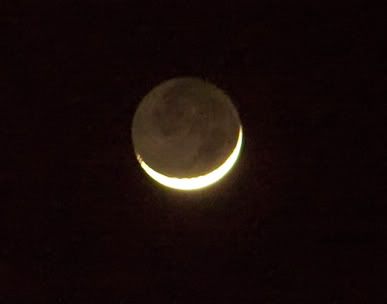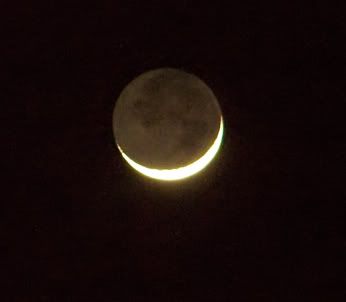I looked out the window early in the evening, and saw the clouds had cleared, and there, low to the horizon was a spectacular very early moon, clearly showing the Earthshine. I grabbed the camera, went back upstairs and snapped a bunch of shots. This is the best pair of a bad set. Ah well, the moon had gone into hiding by the time I managed to download them to the computer. I only ran noiseware on them. This is the Z2 at full zoom, ISO400 propped on the window frame upstairs. I don't recall the exposure time, I took so many at different lengths.

So I setup and powered up the mount. I've just realised I didn't even check to see if it was level, this might explain some of the peculiarities I saw, I'll come onto those in a mo. I'm to used to the plonk and go approach of the camera tripod. Ah well. First off, set the date and time. For some peculiar reason, the mount doesn't appear to have a functional clock, it's most odd. I checked the clock about thirty minutes in, by trying a one star align and it read the time I'd set previously. Anyway, I set the date and time, and used the SkyAlign function. This is so easy it's almost ridiculous. Following the instructions on the handset, you firstly align the RDF on a bright star, then using a low power eyepiece, centre it, then using a high power eyepiece centre again. I will confess I cheated. I only used the 5mm Hyperion and just centered it once and verified the second time. Then onto another bright star and repeat, and again with a third. Ideally these need to be as far apart as possible. I opted for one in the north (Almach), one from the west (Mirfak) and one in the South (Sirius). I did fluff the align of Sirius, I pressed the wrong button on the handset and hit Align instead of Enter, hey ho.
The handset sat there with the Celestron equivalent of the windows egg timer for a moment whilst it worked out the stars I'd selected, then said alignment successful. So onto the test. First up, Saturn. I selected Planet, then scrolled through the two options (the software only allowing me to select those above the horizon, I'd set it like that) and hit enter. Away went the mount. slew around and up. What I hadn't realised on that first goto was that the mount always takes a slow approach to an object. It slews quickly then slows and slows again, before entering tracking mode. Anyway, mr impatient that I am, helped it along a little with the manual slew controls. This may also have messed up the alignment a little. Anyway, I got Saturn centered at 80x. The usual spectacular views. I could hear the motors ticking away quietly in the background as they adjusted the scope for tracking. Whereas before looking at Saturn, she had swept majestically through the entire field of view in less than a minute, the mount kept her there in the FOV for well over a minute before she started to drift off towards the side. Bringing her back centrally again, only required a slight touch on the handset arrow keys. I watched her for about 5 minutes, only needing a little adjustment twice. Already this mount is making things so much easier.
I then selected M (Messier object) and went for M44, the Beehive. I deliberatly only went for objects I knew where to locate them so that I could verify the mount was slewing and aligning as expected. This time, I didn't interfere with the mount and let it finish the slew properly before looking in the eyepiece. M44 wasn't quite central, oddly the same amount that Saturn ended up out. Still, it got me there and kept the tracking with only a little drift. Then I went for another Planet, Mars, nice and high overhead. I'd changed the mount configuration to allow the mount to slew much higher without a warning, as my scope is much shorter than the refractor supplied. And there was no problems with the slew and no warning message on the handset. Again the goto was out by just that little bit.
I then decided I'd try out whether the old manual hunt was still afoot. I manually slewed the scope around to a known location, this time I chose Mirfak and had a look at the Alpha Persei association. Using the direction buttons I lined Mirfak up in the RDF and the motors were still ticking keeping the tracking going. The association was held in the FOV for some time, ok, I couldn't see it all, but it was there and tracking. I did note that the RDF that Celestron supplied with the 60mm appears to draw power from the mount and is not self powered. The RDF is turned off once the alignment process is compelte, at least that's what the handset is indicating. This would mean that using the supplied equipment instead of my Konus would make manual hunting for objects nigh on impossible without purchasing additional equipment. Looking at the attachment on the bottom of the RDF, the Sky Surfer III should fit however.
I then used the goto a couple more times to slew to M36 and M41. In both cases, the goto was a little high and I had to manually slew onto target. Then I went back to Saturn. It was during this last slew I realised that the AA batteries I had driving the mount were obviously beginning to fade, the motors were no longer sounding quite so even and when the mount slewed in both Alt and Az it was noticeable slower than in just one plane. I had a look at Saturn again for a few more minutes, the tracking was still fine. At this point, with the cold seeping in under the coat, feeling very hungry as I hadn't had dinner yet (the mount was the higher priority), and the batteries failing I packed up and went back inside.
In amongst all that testing, I spotted a couple of odd looking DSO's whose names intrigued me, I don't recall which, and figured I'd see where the mount took me. Hit enter, the mount slewed around to the easy and pointed first into the trees, no danger of seeing anything through there except the blackness of the trunk. Then the other one, again slewed around to the south this time and the scope got lower, and lower and lower until it was just below the top of the hedge. Not that you can see anything that low down to the south in the murk.
If only a short session, very enjoyable, and a very successful test. I must remember to ensure the mount is level and not fluff the alignment steps. I think it was these two that caused the mount to always be out the same amount in the same direction on every goto slew. I have now ordered the maplin power tank so won't have to rely on the AA batteries once this current storm is passed. I think it's safe to say that this mount and I are going to get along quite well.
It has just occurred to me, that with the Nexstar 60SLT, my Konus Vista 80s, the bins and tripod adapter and the two camera tripods I have, I could have a very small and quiet little star party in my back garden, now there's a thought, something for the future when my friends come around bringing beer and it's a bit warmer maybe.
Monday, 10 March 2008
Testing out the Nexstar SLT
Subscribe to:
Post Comments (Atom)







No comments:
Post a Comment